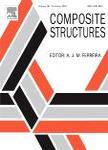版权所有:内蒙古大学图书馆 技术提供:维普资讯• 智图
内蒙古自治区呼和浩特市赛罕区大学西街235号 邮编: 010021

作者机构:Naval Postgrad Sch Dept Mech & Aerosp Engn Monterey CA 93943 USA
出 版 物:《COMPOSITE STRUCTURES》 (复合材料结构)
年 卷 期:2013年第105卷
页 面:269-278页
核心收录:
学科分类:08[工学] 0805[工学-材料科学与工程(可授工学、理学学位)] 080502[工学-材料学] 0801[工学-力学(可授工学、理学学位)]
基 金:ONR Solid Mechanics Program
主 题:Fluid-structure interaction Modal analysis Vibration Modal curvature
摘 要:The study examined the effect of fluid-structure interaction on global dynamic properties such as vibrational frequency, mode shape, modal curvature, as well as free vibrational responses along E-glass composite, carbon composite, and aluminum beams, respectively. The digital image correlation technique was used to measure the free vibrational responses along the beams in air and water, respectively. The vibration submerged in water exhibited higher frequency modes than the dry vibration under the same excitation. Experimental modal analysis showed that the mode shapes were very close for an aluminum beam with and without the FSI effect while there was a modest difference for a carbon composite beam because the PSI effect is greater for the composite beam. Modal curvatures for the both beams are more influenced by PSI, especially for the composite beam. The curvature is directly related to the bending strain of the beam. This explains why the difference in strains measured for composite structures in air and water, respectively, varies significantly from location to location of the structures under impact loading. One location has much greater difference in strains than another location. The FSI can change potential failure locations of the composite structures because of the change in modal curvatures. Published by Elsevier Ltd.